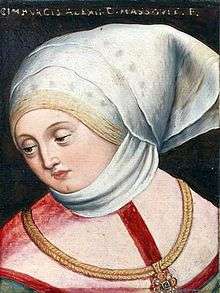Cymburgis of Masovia
| Cymburgis of Masovia | |
|---|---|
 Cymburgis on a posthumous portrait | |
| Spouse(s) | Ernest, Duke of Austria |
| Noble family |
House of Piast (by birth) House of Habsburg (by marriage) |
| Father | Siemowit IV, Duke of Masovia |
| Mother | Alexandra of Lithuania |
| Born |
1394 or 1397 Warsaw, Duchy of Masovia |
| Died |
28 September 1429 Türnitz |
| Buried | Lilienfeld Abbey |
Cymburgis (also Cimburgis, Zimburgis or Cimburga) of Masovia (Polish: Cymbarka mazowiecka; 1394 or 1397 – September 28, 1429), was a Polish princess member of the House of Piast in the Masovian branch.
She was the second daughter of Siemowit IV, Duke of Masovia and Alexandra, a daughter of Algirdas, Grand Duke of Lithuania and sister of King Władysław II Jagiełło of Poland.
Life
Though his elder brother William's engagement with the Polish princess Jadwiga had mortifyingly failed, Ernest after the death of his first wife Margaret of Pomerania proceeded to Kraków to court Cymburgis. The wedding took place on 25 January 1412 in Buda (German: Ofen), at the residence of Sigismund, Holy Roman Emperor. At the time the Emperor mediated negotiations between her uncle Władysław II Jagiełło and the Teutonic Knights.[1] Though not approved by the Habsburg family, the marriage turned out to be a happy one. As the mother of the later Emperor Frederick III, Cymburgis, after Gertrude of Hohenburg, became the second female ancestor of all later Habsburgs, as only his branch of the family survived in the male line.
Although controversial, it has been claimed (since at least by Robert Burton in 1621[2]) that she brought the distinctive protruding lower lip (prognathism) into the family, a particular physical characteristic of most members of the family for many generations until the 18th century.[3] It can even be recognized in some of her distant descendants today (though not as markedly) as Alphonse XIII. Cymburgis' statue in the Innsbruck Hofkirche church however does not show this feature.[4] However, her husband's great-grandfather Albert I, Duke of Austria is presented in one portrait with it.[5]
Tradition has it that she was also known for her exceptional strength, which, for example, she showed by driving nails into the wall with her bare hands and cracking nuts between her fingers.[6] Strength also distinguished one of her descendants, Augustus II the Strong, who used to break horseshoes with his bare hands. Cymburgis outlived her husband and died at Türnitz in present-day Lower Austria. She is buried at Lilienfeld Abbey.
Issue
During her marriage, Cymburgis bore her husband nine children, of whom only four survive infancy:[7][8][9][10]
- Frederick III, Holy Roman Emperor (b. Innsbruck, 21 September 1415 - d. Linz, 19 August 1493).
- Margaret of Austria (b. Wiener Neustadt, 1416 - d. Altenburg, 12 February 1486), married Frederick II, Elector of Saxony.
- Albert VI, Archduke of Austria (b. Vienna, 18 December 1418 - d. Vienna, 2 December 1463).
- Catherine of Austria (b. Wiener Neustadt, 1420 - Schloss Hohenbaden, 11 September 1493), married Charles I, Margrave of Baden-Baden.
- Ernest II of Austria (b. Wiener Neustadt, 1420 - d. Wiener Neustadt, 10 August 1432).
- Alexandra of Austria (b. and d. Wiener Neustadt, 1421).
- Anna of Austria (b. Wiener Neustadt, 1422 - d. Wiener Neustadt, 11 November 1429).
- Leopold of Austria (b. and d. Wiener Neustadt, 1424).
- Rudolph of Austria (b. and d. Wiener Neustadt, 1424).
Ancestry
| Ancestors of Cymburgis of Masovia | ||||||||||||||||||||||||||||||||||||||||||||||||||||||||||||||||||||||||||||||||||||||||||||||||||||||||||||||||||||||||||||||||||||||||||||||||||||||||||||||||||||||||||||||||||||||||||||||||||||||||||||||||||||||||||||||||||||||||||||||||||||||||||||||||||||||||||||||||||||||||||||||||||||||||||||||||||||||||||||||||||||||||||||||||||||||||||||||||||||||||||||||||||||||||||||||||||||||||||||||||||||||||||||||||||||||||||||||||||||||||||||||||||||||||||||||||||||||||||||||||||||||||||||
|---|---|---|---|---|---|---|---|---|---|---|---|---|---|---|---|---|---|---|---|---|---|---|---|---|---|---|---|---|---|---|---|---|---|---|---|---|---|---|---|---|---|---|---|---|---|---|---|---|---|---|---|---|---|---|---|---|---|---|---|---|---|---|---|---|---|---|---|---|---|---|---|---|---|---|---|---|---|---|---|---|---|---|---|---|---|---|---|---|---|---|---|---|---|---|---|---|---|---|---|---|---|---|---|---|---|---|---|---|---|---|---|---|---|---|---|---|---|---|---|---|---|---|---|---|---|---|---|---|---|---|---|---|---|---|---|---|---|---|---|---|---|---|---|---|---|---|---|---|---|---|---|---|---|---|---|---|---|---|---|---|---|---|---|---|---|---|---|---|---|---|---|---|---|---|---|---|---|---|---|---|---|---|---|---|---|---|---|---|---|---|---|---|---|---|---|---|---|---|---|---|---|---|---|---|---|---|---|---|---|---|---|---|---|---|---|---|---|---|---|---|---|---|---|---|---|---|---|---|---|---|---|---|---|---|---|---|---|---|---|---|---|---|---|---|---|---|---|---|---|---|---|---|---|---|---|---|---|---|---|---|---|---|---|---|---|---|---|---|---|---|---|---|---|---|---|---|---|---|---|---|---|---|---|---|---|---|---|---|---|---|---|---|---|---|---|---|---|---|---|---|---|---|---|---|---|---|---|---|---|---|---|---|---|---|---|---|---|---|---|---|---|---|---|---|---|---|---|---|---|---|---|---|---|---|---|---|---|---|---|---|---|---|---|---|---|---|---|---|---|---|---|---|---|---|---|---|---|---|---|---|---|---|---|---|---|---|---|---|---|---|---|---|---|---|---|---|---|---|---|---|---|---|---|---|---|---|---|---|---|---|---|---|---|---|---|---|---|---|---|---|---|---|---|---|---|---|---|---|---|---|---|---|---|---|---|---|---|---|---|---|---|---|---|---|---|---|---|---|---|---|---|---|---|---|---|---|---|---|---|---|---|---|---|---|---|---|---|---|---|---|---|---|---|---|---|---|---|---|---|---|---|---|---|---|---|---|---|---|---|---|---|---|---|---|---|---|---|---|---|---|---|---|---|---|---|---|---|---|---|---|---|---|
| ||||||||||||||||||||||||||||||||||||||||||||||||||||||||||||||||||||||||||||||||||||||||||||||||||||||||||||||||||||||||||||||||||||||||||||||||||||||||||||||||||||||||||||||||||||||||||||||||||||||||||||||||||||||||||||||||||||||||||||||||||||||||||||||||||||||||||||||||||||||||||||||||||||||||||||||||||||||||||||||||||||||||||||||||||||||||||||||||||||||||||||||||||||||||||||||||||||||||||||||||||||||||||||||||||||||||||||||||||||||||||||||||||||||||||||||||||||||||||||||||||||||||||||
Footnotes
- ↑ Urban, William (2003). Tannenberg and After. Chicago: Lithuanian Research and Studies Center. p. 191. ISBN 0-929700-25-2.
- ↑ Manfred Draudt, Société Française Shakespeare
- ↑ London Science Museum
- ↑ Hofkirche website
- ↑ Genealogy
- ↑ de.wikisource.org: Biographisches Lexikon des Kaiserthums Oesterreich(German)
- ↑ Complete Genealogy of the House of Habsburg [retrieved 18 June 2014].
- ↑ Genealogical Database by Herbert Stoyan [retrieved 18 June 2014].
- ↑ Roglo.eu [retrieved 18 June 2014].
- ↑ AUSTRIA in Charles Crawley: Medieval Lands [retrieved 18 June 2014].